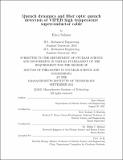Quench dynamics and fiber optic quench detection of VIPER high temperature superconductor cable
Author(s)
Salazar, Erica
DownloadThesis PDF (33.24Mb)
Advisor
Hartwig, Zachary
Terms of use
Metadata
Show full item recordAbstract
High temperature superconductors (HTS) enable many high field magnet applications—such as magnetic fusion devices—to operate at superior current densities, temperatures, and fields compared to low temperature superconductor (LTS) based magnets. However, HTS introduces new challenges: slow quench propagation velocities (orders of magnitude slower than LTS) make quench events difficult to detect which increases risk of permanent damage to the magnet or loss of service if undetected. This thesis describes the test campaign, results, and analysis of an experimental quench test on the VIPER HTS Delta cable, a prototype HTS cable designed in collaboration between MIT-PSFC and Commonwealth Fusion Systems, and supports the results with a numerical 3D Matlab model. The quench tests were performed at the SULTAN test facility in Switzerland. This thesis experimentally measures and verifies the propagation velocities on VIPER HTS cable (the first quench measurement on a HTS cable in fusion-relevant conditions), and proposes a method to standardize quench propagation velocity measurements in HTS cables when fully developed velocities or quench conditions are not possible. To address the challenge of slow quench propagation velocities, a method to predict the initiation of a quench (by up to tens of seconds before thermal runaway initiates) by measuring and calculating a quench temperature threshold parameter is described. Additionally, a novel temperature-based fiber optic technology (FBG and ULFBG) is validated as a promising quench detection technology that is immune to the challenging electromagnetic induced noise affecting conventional voltage-based quench detection systems. The temperature-based quench prediction parameter in combination with the temperature-based fiber optic quench detection technology enables detection of quench initiation before the quench event is fully developed. Robust quench detection technology enables HTS cable designs to operate at higher currents relative to the critical current (Ic). The VIPER Delta cable exhibited high cryostability (did not quench when exposed to local thermal disturbances) when tested up to 0.9 of Ic at 10 K and up to full Ic at 20 K. Higher operating current relative to Ic is desirable because it decreases the required amount of HTS tape and cross sectional area of the cable which significantly reduces the cost of the cable design and allows more use of the cable’s cross sectional area for other magnet system requirements such as structural or insulation requirements. By mitigating the quench dynamics and detection risks of employing HTS in high field applications, more opportunities to expand the operation and innovation of high field magnets exist. In particular, the SPARC program and future tokamak devices will have a pathway to implement smaller and more economical, compact fusion devices for a future with clean, limitless energy production.
Date issued
2021-09Department
Massachusetts Institute of Technology. Department of Nuclear Science and EngineeringPublisher
Massachusetts Institute of Technology